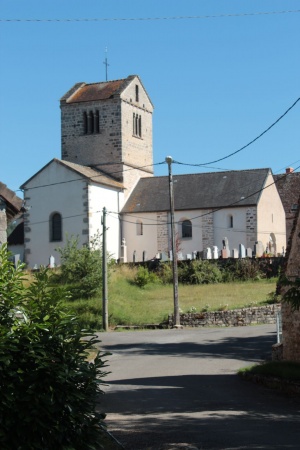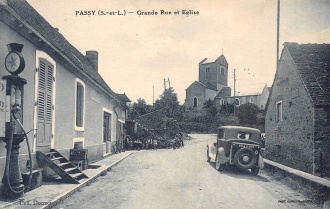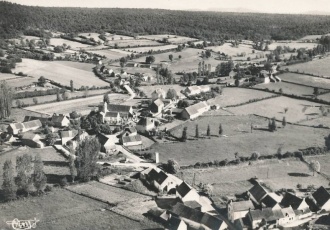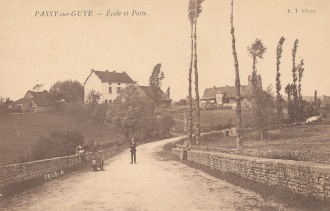Eglise Saint-Roch à Passy : Différence entre versions
(→Rénovations / Etat) |
(→Iconographie ancienne et récente) |
||
| Ligne 86 : | Ligne 86 : | ||
<gallery mode="slideshow" showthumbnails > | <gallery mode="slideshow" showthumbnails > | ||
| − | + | Fichier:PassyEgliseExt (1).JPG | |
| + | Fichier:PassyEgliseExt (2).JPG | ||
| + | Fichier:PassyEgliseExt (3).JPG | ||
| + | Fichier:PassyEgliseExt (4).JPG | ||
| + | Fichier:PassyEgliseExt (5).JPG | ||
| + | Fichier:PassyEgliseExt (6).JPG | ||
| + | Fichier:PassyEgliseExt (7).JPG | ||
| + | Fichier:PassyEgliseExt (8).JPG | ||
| + | Fichier:PassyEgliseExt (9).JPG | ||
| + | Fichier:PassyEgliseExt (10).JPG | ||
| + | Fichier:PassyEgliseExt (11).JPG | ||
| + | Fichier:PassyEgliseExt (12).JPG | ||
| + | Fichier:PassyEgliseExt (13).JPG | ||
| + | Fichier:PassyEgliseExt (14).JPG | ||
| + | Fichier:PassyEgliseExt (15).JPG | ||
| + | Fichier:PassyEgliseExt (16).JPG | ||
| + | Fichier:PassyEgliseExt (17).JPG | ||
| + | Fichier:PassyEgliseExt (18).JPG | ||
| + | Fichier:PassyEgliseExt (19).JPG | ||
| + | Fichier:PassyEgliseExt (20).JPG | ||
| + | Fichier:PassyEgliseExt (21).JPG | ||
| + | Fichier:PassyEgliseExt (22).JPG | ||
| + | Fichier:PassyEgliseExt (23).JPG | ||
| + | Fichier:PassyEgliseExt (24).JPG | ||
| + | Fichier:PassyEgliseExt (25).JPG | ||
| + | Fichier:PassyEgliseExt (26).JPG | ||
| + | Fichier:PassyEgliseExt (27).JPG | ||
| + | Fichier:PassyEgliseExt (28).JPG | ||
| + | Fichier:PassyEgliseExt (29).JPG | ||
| + | Fichier:PassyEgliseExt (30).JPG | ||
| + | Fichier:PassyEgliseExt (31).JPG | ||
| + | Fichier:PassyEgliseExt (32).JPG | ||
| + | Fichier:PassyEgliseExt (33).JPG | ||
| + | Fichier:PassyEgliseExt (34).JPG | ||
| + | Fichier:PassyEgliseExt (35).JPG | ||
| + | Fichier:PassyEgliseExt (36).JPG | ||
| + | Fichier:PassyEgliseExt (37).JPG | ||
| + | Fichier:PassyEgliseExt (38).JPG | ||
| + | Fichier:PassyEgliseExt (39).JPG | ||
| + | Fichier:PassyEgliseExt (40).JPG | ||
| + | Fichier:PassyEgliseExt (41).JPG | ||
| + | Fichier:PassyEgliseExt (42).JPG | ||
| + | Fichier:PassyEgliseExt (43).JPG | ||
| + | Fichier:PassyEgliseExt (44).JPG | ||
| + | Fichier:PassyEgliseInt (1).JPG | ||
| + | Fichier:PassyEgliseInt (2).JPG | ||
| + | Fichier:PassyEgliseInt (3).JPG | ||
| + | Fichier:PassyEgliseInt (4).JPG | ||
| + | Fichier:PassyEgliseInt (5).JPG | ||
| + | Fichier:PassyEgliseInt (6).JPG | ||
| + | Fichier:PassyEgliseInt (7).JPG | ||
| + | Fichier:PassyEgliseInt (8).JPG | ||
| + | Fichier:PassyEgliseInt (9).JPG | ||
| + | Fichier:PassyEgliseInt (10).JPG | ||
| + | Fichier:PassyEgliseInt (11).JPG | ||
| + | Fichier:PassyEgliseInt (12).JPG | ||
| + | Fichier:PassyEgliseInt (13).JPG | ||
| + | Fichier:PassyEgliseInt (14).JPG | ||
| + | Fichier:PassyEgliseInt (15).JPG | ||
| + | Fichier:PassyEgliseInt (16).JPG | ||
| + | Fichier:PassyEgliseInt (17).JPG | ||
| + | Fichier:PassyEgliseInt (18).JPG | ||
| + | Fichier:PassyEgliseInt (19).JPG | ||
| + | Fichier:PassyEgliseInt (20).JPG | ||
| + | Fichier:PassyEgliseInt (21).JPG | ||
| + | Fichier:PassyEgliseInt (22).JPG | ||
| + | Fichier:PassyEgliseInt (23).JPG | ||
| + | Fichier:PassyEgliseInt (24).JPG | ||
| + | Fichier:PassyEgliseInt (25).JPG | ||
| + | Fichier:PassyEgliseInt (26).JPG | ||
| + | Fichier:PassyEgliseInt (27).JPG | ||
| + | Fichier:PassyEgliseInt (28).JPG | ||
| + | Fichier:PassyEgliseInt (29).JPG | ||
| + | Fichier:PassyEgliseInt (30).JPG | ||
| + | Fichier:PassyEgliseInt (31).JPG | ||
| + | Fichier:PassyEgliseInt (32).JPG | ||
| + | Fichier:PassyEgliseInt (33).JPG | ||
| + | Fichier:PassyEgliseInt (34).JPG | ||
| + | Fichier:PassyEgliseInt (35).JPG | ||
| + | Fichier:PassyEgliseInt (36).JPG | ||
| + | Fichier:PassyEgliseInt (37).JPG | ||
| + | Fichier:PassyEgliseInt (38).JPG | ||
| + | Fichier:PassyEgliseInt (39).JPG | ||
| + | Fichier:PassyEgliseInt (40).JPG | ||
| + | Fichier:PassyEgliseInt (41).JPG | ||
| + | Fichier:PassyEgliseInt (42).JPG | ||
| + | Fichier:PassyEgliseInt (43).JPG | ||
| + | Fichier:PassyEgliseInt (44).JPG | ||
| + | Fichier:PassyEgliseInt (45).JPG | ||
| + | Fichier:PassyEgliseInt (46).JPG | ||
| + | Fichier:PassyEgliseInt (47).JPG | ||
| + | Fichier:PassyEgliseInt (48).JPG | ||
| + | Fichier:PassyEgliseInt (49).JPG | ||
| + | Fichier:PassyEgliseInt (50).JPG | ||
| + | Fichier:PassyEgliseInt (51).JPG | ||
| + | Fichier:PassyEgliseInt (52).JPG | ||
| + | Fichier:PassyEgliseInt (53).JPG | ||
| + | Fichier:PassyEgliseInt (54).JPG | ||
| + | Fichier:PassyEgliseInt (55).JPG | ||
| + | Fichier:PassyEgliseInt (56).JPG | ||
| + | Fichier:PassyEgliseInt (57).JPG | ||
| + | Fichier:PassyEgliseInt (58).JPG | ||
| + | Fichier:PassyEgliseInt (59).JPG | ||
| + | Fichier:PassyEgliseInt (60).JPG | ||
| + | Fichier:PassyEgliseInt (61).JPG | ||
| + | Fichier:PassyEgliseInt (62).JPG | ||
| + | Fichier:PassyEgliseInt (63).JPG | ||
</gallery> | </gallery> | ||
Version du 5 mai 2020 à 22:22
L’église paroissiale romane Saint-Roch est située dans la commune de Passy, dans le département de la Saône-et-Loire, en Bourgogne-Franche-Comté. Elle laisse paraître deux phases de construction distinctes. La première daterait du Xe siècle. Une chapelle Saint-Germain est en effet mentionnée dans une charte de Cluny datée de 962. Il n’en resterait aujourd’hui que la travée sous clocher avec coupole sur trompes. La deuxième phase pourrait remonter au XIIe siècle et concerne le reste de l’église, à l’exception du mur sud de la nef. Celui-ci date vraisemblablement de l’importante rénovation du XVIe siècle. Les causes de cette dernière sont incertaines : incendie, conséquences des Guerres de Religion ou de la présence d’une seigneurie, manque d’entretien…Toujours est-il que le mur sud de la nef est rebâti sur les bases romanes, l’abside remaniée et le portail principal créé. Plusieurs projets de rénovation sont avancés au XIXe siècle, mais tous ne sont pas concrétisés. En 1879, une rénovation générale de l’édifice est toutefois entreprise. C’est à cette occasion que sont ajoutées les chapelles qui forment les bras du transept. L’église abrite un mobilier assez important. La pièce la plus remarquable est probablement le tabernacle du XVIIe siècle taillé dans un bloc de pierre noire.
| Adresse | Pré Bouqueton, 71220 Passy |
| Coordonnées GPS | 46°32'26.5"N 4°32'05.5"E |
| Paroisse de rattachement | Paroisse des Monts du Charolais |
| Protection Monuments Historiques | / |
Sommaire
- 1 Historique
- 2 Description architecturale
- 3 Inventaire décor et mobilier
- 4 Rénovations / Etat
- 5 Actualités
- 6 Visite
- 7 Association engagée
- 8 Iconographie ancienne et récente
- 9 Plans cadastraux
- 10 Bibliographie
- 11 Sources
- 12 Propriétaire / Contact
- 13 Patrimoine local et/ou folklore
- 14 Notes et références
Historique
Description architecturale
GLOSSAIRE : Bourgogne Romane
Inventaire décor et mobilier
Rénovations / Etat
- Rénovations :
XIXe :
1822 : projet de restauration (la réalité finale des travaux retenus est inconnue)
1879 : restauration générale de l’église, ajout des chapelles de chaque côté de la travée sous clocher.
1883 : enrichissement du mobilier
1886 : projet de travaux d’assainissement de l’édifice (réalisation indéterminée)
XXe :
1999 : restauration de l’édifice (couverture, enduits)
XXIe :
Travaux d’entretien.
- Etat :
L’église Saint-Roch est en bon état général et est régulièrement entretenue. Elle a fait l’objet d’une sécurisation permettant son ouverture et sa protection.
- Classement :
/
Actualités
Pour suivre l’actualité de l’église, contacter directement la mairie.
Visite
L’église est ouverte pendant la saison estivale. Pour programmer une visite, se renseigner auprès de la mairie.
L’accès à l’édifice semble compliqué pour les personnes à mobilité réduite. L’accès au cimetière attenant, en hauteur par rapport à la chaussée, se fait par un grand escalier de pierre (sauf portail). Par ailleurs, l’entrée de l’église accuse une marche assez importante.
Association engagée
/
Iconographie ancienne et récente
Crédit Photos: CEP
Plans cadastraux
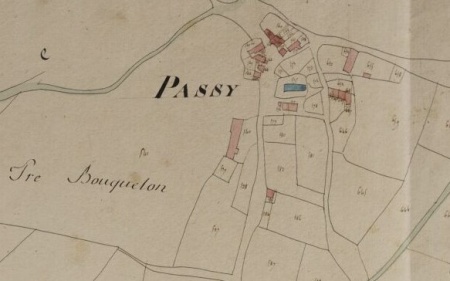 Cadastre de 1833, archives départementales de Saône-et-Loire |
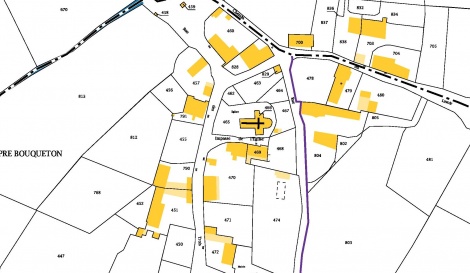 Cadastre actuel, cadastre.gouv |
Bibliographie
- RIGAULT, Jean, Dictionnaire topographique du département de la Saône-et-Loire, 2008.
- VIREY, Jean, Les églises romanes de l’ancien diocèse de Mâcon, Mâcon, Protat, 1935, 474p.
Sources
- Oursel, Anne-Marie et Raymond, Fiche d’inventaire départemental, 1969 :
Archives départementales de Saône-et-Loire
- Fiche édifice de la Bourgogne Romane :
- Fiche édifice de la Sauvegarde de l’Art Français :
Propriétaire / Contact
Commune de Passy
03 85 59 49 62
mairie-de-passy@wanadoo.fr
Patrimoine local et/ou folklore
- Le Châtelard :
Bâtiment flanqué au sud d'une tour ronde, équipée de canonnières. La tour-pigeonnier comporte trois meurtrières : une seule, tournée vers la cour, est visible. La seconde est en partie obturée par la galerie mâconnaise. La troisième, visible seulement quand on est dans la tour est tournée vers l'arrière.
Eglise romane datant du XIe siècle, et dont la nef a été reconstruite et considérablement agrandie au XIXe siècle.
Dans l’abside, une peinture de la fin du XIXe siècle orne la voûte et représente le Couronnement de la Vierge par le Christ.
Eglise romane construite au XIIe siècle. La nef a été entièrement rebâtie au XIXe siècle.
Elle abrite un beau bénitier roman dont la cuve est ornée de masques sculptés.
